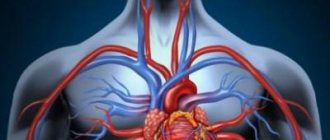Sometimes during intrauterine development, while the fetus is still in the mother’s body, disturbances may occur during the formation of the heart, which leads to abnormal structure of the walls of the heart, abnormal arrangement of blood vessels and valves. As a result, a mixture of oxygenated and deoxygenated blood occurs, or its improper distribution throughout the circulation. As a result, the body does not receive enough oxygen, which leads to the appearance of characteristic symptoms.
The main signs of heart disease in children:
Heart disease can manifest itself differently at different ages, so it is advisable to distinguish 3 age groups: infants (from 0 to 1-2 years), children of preschool and primary school age (from 2 to 10 years) and adolescents.
In infancy, a child cannot complain when something bothers him, the only means of communication is crying, so the symptoms that parents themselves can pay attention to come first:
- Cyanosis or pallor. As a result of poor blood supply to the peripheral vessels and insufficient oxygen supply to the skin, it acquires a characteristic violet-bluish tint, especially in the area of the nasolabial triangle and under the nails, but with severe lesions, cyanosis can cover the entire body.
- The baby does not attach well to the breast, is distracted during feeding, and breathes or sweats frequently. He does not have enough energy for full suction due to insufficient oxygen supply.
- Loss of consciousness, fainting. An alarming symptom that often occurs when the child is active (during feeding, during active movement). This is due to insufficient oxygen supply to the brain.
- Slow weight gain. Mainly due to the fact that the baby has difficulty sucking the breast or bottle, and therefore does not receive enough nutrients.
- Fatigue and shortness of breath. The child does not want to move actively, looks lethargic, tired, and does not show interest in games. At an older age, a characteristic symptom may occur: during play, the child turns blue and squats down. This allows the heart to distribute blood more correctly in case of septal defects between the right and left ventricles and abnormal arrangement of blood vessels (Tetralogy of Fallot).
All these symptoms can occur due to many reasons and are even normal, but in any case they indicate that it is worth consulting a doctor in order to identify possible problems at the earliest stage and promptly eliminate them.
Children of preschool and primary school age are more active than infants, in addition, they can describe some of their sensations, and therefore less pronounced heart damage that was not detected at an earlier age may appear.
- Delayed physical development. Children with heart disease look younger than their peers and have difficulty playing outdoor games
- Shortness of breath, excessive sweating, cyanosis. They occur due to insufficient oxygen supply to organs and tissues.
- Dizziness and fainting. Dizziness can occur as a result of many reasons that are not at all related to the heart, however, frequent attacks, especially those accompanied by fainting, should alert parents to diseases of the cardiovascular system.
- Rhythm disturbances. Although children of primary preschool age are not always able to correctly describe their sensations, they may complain that their heart is “freezing” or “pounding.”
- Discomfort in the chest area, pain radiating to the left arm, cold sticky sweat can indicate serious heart problems.
In most cases, adolescents can describe their sensations; most congenital anomalies have already been identified by this age, but some problems develop over a long period of time and appear in relatively adulthood. You should pay attention to:
- Fainting due to physical activity indicates the need for an in-depth examination, especially if there have been cases of sudden death in the family.
- Increased fatigue. The inability to maintain the same level of activity as peers may be a consequence of a sedentary lifestyle, but when combined with shortness of breath, frequent dizziness or fainting, it may indicate problems with the cardiovascular system.
- Shortness of breath during physical activity, which occurs earlier than in peers, should alert parents. The most common cause is asthma, but heart disease is also a common symptom.
- Chest pain radiating to the left arm.
- Heart rhythm disturbances.
Features of the cardiovascular system of children
The child’s cardiovascular system has a number of anatomical features that determine the characteristics of its functioning. So, when compared with the total body weight, the heart of a newborn is much larger than the heart of an adult. At the same time, the organ grows quite intensively, and by the age of 3 years its weight increases three times compared to a newborn, and by 6 years - 11 times.
Due to the high intensity of metabolism, as well as due to the peculiarities of regulation of the work of the heart muscle, the heart rate in children is higher than in adults: in newborns, the heart rate reaches 140-160 beats per minute, by the first year it decreases to 140, by 5 By the age of 15, the heart rate drops to 100 beats per minute, and by the age of 15 it reaches a normal level (approximately 80 beats per minute).
Also, in childhood, the heart has some anatomical features that create the preconditions for “wrong” blood flow. This so-called foramen ovale is an opening through which the right and left atria can communicate. Over time, it should close in the child, and doctors will certainly monitor this process.
Heart disease in children is relatively common (approximately 1 in 100 people)
Bibliography:
- Anderson RH, Baker FJ, Macartney FJ. Pediatric Cardiology. 2nd ed London: Churchill Livingstone
- A. John Camm, Thomas F. Luscher, Gerald Maurer, Patrick W. Serruys. ESC CardioMed. Oxford University Press
- rch.org.au/kidsinfo/fact_sheets/heart_problems_in_children/
- Secondscount.org/pediatric-center/pediatric-detail-2
- Cardioschool.ru/for-patients/page-112
Author of the article: Doctor - Shugushev Zaur Khasanovich, Chief Cardiologist of the Central Directorate of Healthcare - a branch of JSC Russian Railways.
Features of CVS in children
The cardiovascular system of children differs significantly from the cardiovascular system of adults. The difference is clearly visible both during a routine examination and according to the results of electrocardiography (ECG). These differences greatly frighten parents and force them to urgently consult a doctor. Therefore, in this article we will try to consider all the main features of the cardiovascular system in a child, which may cause concern to his parents.
The cardiovascular system of children has its own anatomical and physiological characteristics compared to the cardiovascular system of adults. For example, when compared with the total body weight, the heart of a newborn is much larger than the heart of an adult, and rapid growth is observed, and by about three years the heart weight increases almost 3 times, and by 6 years almost 11 times.
Due to the peculiarities of the nervous regulation of the heart and the high intensity of metabolism, the heart rate in children is much higher than in an adult, and only by about 15 years does the heart rate become like that of an adult. The decrease in heart rate (HR) with the age of the child is directly related to the onset of the influence of the vagus nerve on the heart.
In addition, sex differences in heart rate are noticeable in children. So, boys have a lower heart rate than girls.
But the main feature of the heart in a child is respiratory arrhythmia, which is manifested by an increase in heart rate during inhalation and a slowdown during exhalation. In early childhood, arrhythmia is slightly expressed, and from preschool age to 15 years, respiratory arrhythmia is expressed to a significant extent. In children over 15 years of age, as a rule, only isolated cases of respiratory arrhythmia occur.
The heartbeat in young children is very pronounced. This is due to the small amount of subcutaneous fat. As the child ages, subcutaneous fat increases, as a result the heartbeat becomes almost invisible.
The electrocardiogram of a child and an adult has significant differences. First of all, arrhythmia, and secondly, due to the active growth and development of the heart muscle and conduction pathways, changes in the QRS complex are possible, which are manifested by splitting and narrowing of the complex. ECG conclusion: incomplete blockade of the left or right bundle branch.
In addition, all ECG waves are more pronounced in children than in adults. Migration of the pacemaker through the atria may occur, which is due to the formation of new short-term sources of excitation.
In older children, remodeling of the conduction system of the heart occurs, which causes the development of cardiac arrhythmias.
The most common diseases of the cardiovascular system in children
1. Congenital heart defects (CHD) are defects in the structure of the heart cavities or heart vessels, which lead to disruption of their functioning. Congenital defects are most often recorded either on ultrasound during pregnancy or in the first month after birth. Children with congenital heart disease experience rapid fatigue, weakness, small increase in height and weight in the first year of life, and frequent respiratory diseases. Most often, surgical treatment of defects is required.
2. Arterial hypertension. Almost 20% of schoolchildren experience increased blood pressure. Children of prepubertal and pubertal age are most predisposed to increased blood pressure. Depending on the age when the increase in blood pressure first appeared, there may be various reasons. In younger people, increased blood pressure is associated with congenital pathology of the kidneys and cardiovascular system. As you grow older, increased body weight, heredity, etc. take first place among the reasons. Very often, the child does not feel the increased pressure and it is an accidental finding during medical examination. Sometimes children may complain of fatigue, dizziness and headache. At the first stage of treatment, non-drug methods are used, which include normalizing the daily routine, sleep, nutrition and physical activity. If positive dynamics are not observed for some time, then medications are added.
FOR REFERENCE!
Nekrasova Anastasia Mikhailovna.
Doctor – pediatrician, pediatric cardiologist.
Medical
Elektrougli, st. Shkolnaya, no. 49, no. 38.
www.family-mts.rf
Heart diseases that occur in childhood are divided into two main groups: congenital and acquired. Unlike in adults, a large number of heart defects in childhood are mainly congenital heart defects. These children are born with some kind of structural defect. Structural defects are caused by disruption of the normal development of the heart very early in pregnancy (heart development is completed by the 7th week of pregnancy) and even while the mother is unaware of her pregnancy. In most cases, the factor influencing the normal development of the heart remains unknown, but some viral diseases (for example, measles, German measles, mumps, catarrh, certain microbes, etc.) play a role in this. Moreover, heredity (genetically) and chromosomal abnormalities (the risk of heart disease is 50% in children with Down syndrome) are listed as factors that increase the risk of congenital heart disease. Likewise, certain medications (specific drugs used to treat epilepsy and neuropathy) taken during pregnancy, especially during the first three months, and alcohol have been said to cause heart defects. However, it is often impossible to know whether the disease is related to these causes. For this reason, unless there is a definitively proven conclusion, parents should not feel guilty, certain medications (special drugs used to treat epilepsy and neuropathy) taken during pregnancy, especially during the first three months, as well as alcohol, as stated, cause heart defects. However, it is often impossible to know whether the disease is related to these causes.
The level of significance of these structural heart defects can range from a simple problem, such as a small “hole” between the chambers, to more complex and severe conditions, such as failure of the heart or some of its ventricles and valves.
The probability of having a child with a congenital heart defect is 8 in 1000 for each expectant mother. Thus, from 10 to 15 thousand children are born in the country with congenital heart defects. About half of these involve severe illnesses requiring surgery before the patient's first birthday. If parents already have a child with congenital heart disease, the risk for future children is approximately twice the normal rate (16/1000). If the mother or father has any congenital heart defects, the risk ranges from 2% to 16% for the child, depending on the disease and whether the mother or father has it. Today, Specialists trained in this field perform "Fetal Echocardiography" to examine the heart of high-risk fetuses between 16 and 20 weeks of pregnancy to detect serious cardiac abnormalities. However, treatment is not possible while the baby is still in the womb.











